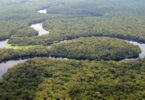Earth is a blue planet, with oceans covering more than 70% of its surface. These vast bodies of water influence the world’s climate, support diverse ecosystems, and connect continents. The Pacific, Atlantic, Indian, Southern, and Arctic oceans all have fascinating secrets. Let’s look at their distinguishing features.
Pacific Ocean | 168,723,000 square kilometers
The Pacific Ocean is the world’s largest and deepest ocean, covering over 63 million square miles. It contains the Mariana Trench, which is the world’s deepest natural point, reaching over 36,000 feet.
The Pacific also has the Great Barrier Reef, a vast coral reef system that supports hundreds of marine species. This ocean, which stretches from the western coasts of the Americas to Asia and Australia, plays an important role in global trade and biodiversity.
Atlantic Ocean | 85,133,000 square kilometers
The Atlantic Ocean, which stretches from the Arctic to the Antarctic, is the world’s second largest ocean. It is notable for its S-shaped basin, which was formed by the movement of tectonic plates over millions of years.
One of its most notable aspects is the Gulf Stream, a strong ocean stream that has a substantial impact on worldwide weather patterns, particularly in Europe and North America. For ages, the Atlantic has served as a significant route for explorers and merchants, connecting the Americas to Europe and Africa.
Indian Ocean | 70,560,000 square kilometers
The Indian Ocean is notable for its warm waters and tropical environment. It occupies around 20% of the Earth’s marine area and is bordered by Asia, Africa, and Australia.
It sustains thriving marine ecosystems that include whale sharks, sea turtles, and the rare coelacanth, a species formerly considered extinct. The Indian Ocean’s monsoon winds also produce seasonal weather variations and have historically influenced regional marine trade.
Southern Ocean | 21,960,000 square kilometers
The Southern Ocean, which encircles Antarctica, is the world’s fourth biggest ocean and one of the most severe habitats on the planet. Its chilly seas are filled with life, including krill and massive blue whales.
The Antarctic Circumpolar Current, the world’s greatest ocean current, runs through the Southern Ocean, connecting all major oceans and transferring nutrients around the planet. Icebergs floating from Antarctica frequently occupy its waterways, resulting in breathtaking, surreal scenes.
Arctic ocean | 15,558,000 square kilometers
The Arctic Ocean is the smallest and shallowest of the five oceans, but it is critical to the Earth’s climate stability. Polar bears, walruses, and narwhals live in this ocean, which is largely covered by sea ice for much of the year.
During the summer, sections of the Arctic Ocean become accessible, allowing for shorter transportation routes across continents. However, its environment is one of the most vulnerable to climate change, with rising temperatures causing ice to melt at a rapid pace.








